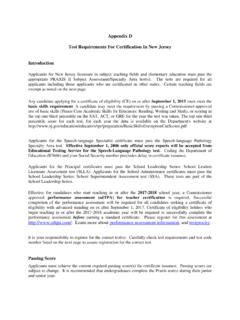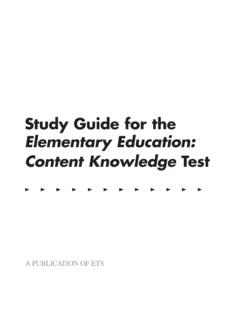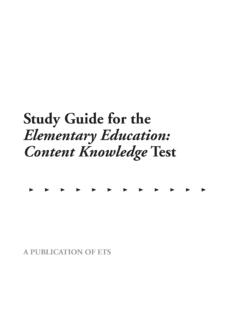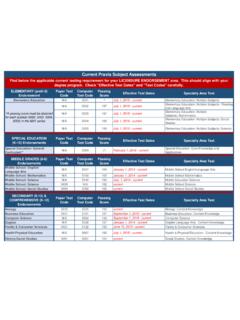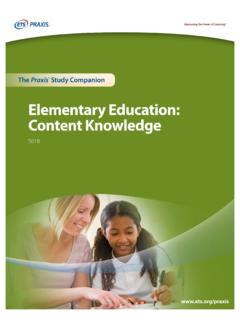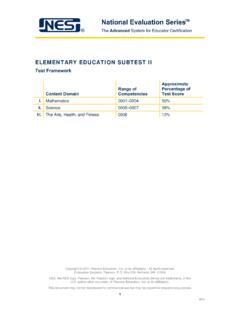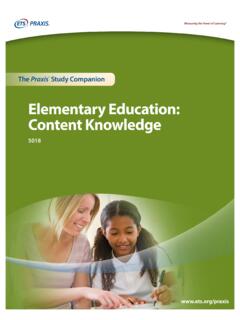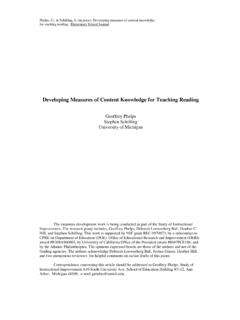Transcription of Student Teaching Evaluation Report
1 Student Teaching Evaluation Report elementary education Placements COOPERATING TEACHER COPY Student Teacher: _____ Student Teacher s Program Code:_____ Semester: _____Year:_____ This is the First Second Placement Cooperating Teacher Name:_____ Placement Location:_____ Page 1 Student Teaching Evaluation Report (STER) Performance Based Evaluation A four-part instrument is used to evaluate Mansfield University Student teachers. SECTION A: Evidence of Ability to Teach Section A consists of an Evaluation of Student teachers classroom performance based on the Association for Childhood education International s (2007) Professional Standards, Pennsylvania Department of education (PDE) Competencies, and the Mansfield University Student Teaching competencies and performance indicators based on the four domains and twenty-two elements described in Charlotte Danielson s book, Enhancing Professional Practice: A Framework for Teaching .
2 See pages 4-16 for the scoring instructions and performance indicators for Section A. SECTION B: Evidence of elementary education content knowledge Section B consists of an Evaluation of Student teachers knowledge of elementary education content . It consists of one item designed specifically for each element in the Association for Childhood education International s Standard 2: Curriculum (2007). See pages 17-21 for the scoring instructions and performance indicators for Section B. SECTION C: Evidence of Ability to Reflect on Teaching (Evaluated by University Supervisor only) Section C consists of evaluations of a series of written exercises that require Student teachers to reflect on their professional development as teachers. Reflection is a vital component in the process of continual growth, as stated in the MU Teacher education Unit Conceptual Framework, Teacher as Reflective Decision-Maker.
3 Section C exercises appear on page 22. SECTION D: Evidence of Ability to Promote P-12 Student Learning (Evaluated by University Supervisor only) Section D consists of a written description of a unit of instruction and documented evidence of P-12 students learning as a result of the Student teacher s instruction. The scoring instructions and Student teacher guidelines appear on pages 23-27. A three page rubric follows the instructions and guidelines. Notes on Grading Process Because each Student teacher is placed in two settings, University Supervisors assign midterm grades as Satisfactory or Unsatisfactory based on the University Supervisor s professional judgment of the Student teacher s knowledge , skills, and dispositions as demonstrated in the first Student Teaching assignment. Final ED 4400 Student Teaching grades are also determined by the University Supervisor; the final grade is based on the accumulated evidence of the Student s performance from the entire Student Teaching experience and total earned points on the STER.
4 For the final ED 4400 Student Teaching course grade, University Supervisors use the Cooperating Teachers scores from Sections A and B in both placements to inform their evaluations on those sections. They do not necessarily average the two placements scores. NOTE: In some cases, the Cooperating Teacher may have indicated that there was insufficient opportunity to observe a particular Student teacher s competency on one of the sections elements. Hopefully, when opportunities were insufficient on any given element in one placement, the other Cooperating Teacher will have had the opportunity to make an observation on that same element. In the event that neither placement afforded sufficient opportunity to observe the same element, University Supervisors may choose to reduce the overall denominator by six points for an element in Section A and/or by four points for an element in Section B.
5 The final page of this STER is used to summarize scores and Report the final grade. If the denominator is reduced, the University Supervisor will cross out the total out of points and adjust the total possible points accordingly so that the Student teacher is not penalized for an opportunity they did not have. Page 2 Association for Childhood education International 2007 Professional Standards 1. DEVELOPMENT, LEARNING AND MOTIVATION Development, Learning, and Motivation Candidates know, understand, and use the major concepts, principles, theories, and research related to development of children and young adolescents to construct learning opportunities that support individual students development, acquisition of knowledge , and motivation. 2. CURRICULUM STANDARDS Reading, Writing, and Oral Language Candidates demonstrate a high level of competence in use of English language arts and they know, understand, and use concepts from reading, language and child development, to teach reading, writing, speaking, viewing, listening, and thinking skills and to help students successfully apply their developing skills to many different situations, materials, and ideas; Science Candidates know, understand, and use fundamental concepts of physical, life, and earth/space sciences.
6 Candidates can design and implement age-appropriate inquiry lessons to teach science, to build Student understanding for personal and social applications, and to convey the nature of science; Mathematics Candidates know, understand, and use the major concepts and procedures that define number and operations, algebra, geometry, measurement, and data analysis and probability. In doing so they consistently engage problem solving, reasoning and proof, communication, connections, and representation; Social studies Candidates know, understand, and use the major concepts and modes of inquiry from the social studies the integrated study of history, geography, the social sciences, and other related areas to promote elementary students abilities to make informed decisions as citizens of a culturally diverse democratic society and interdependent world; The arts Candidates know, understand, and use as appropriate to their own understanding and skills the content , functions, and achievements of the performing arts (dance, music, theater) and the visual arts as primary media for communication, inquiry, and engagement among elementary students .
7 Health education Candidates know, understand, and use the major concepts in the subject matter of health education to create opportunities for Student development and practice of skills that contribute to good health; Physical education Candidates know, understand, and use as appropriate to their own understanding and skills human movement and physical activity as central elements to foster active, healthy life styles and enhanced quality of life for elementary students . 3. INSTRUCTION STANDARDS Integrating and applying knowledge for instruction Candidates plan and implement instruction based on knowledge of students , learning theory, connections across the curriculum, curricular goals, and community; Adaptation to diverse students Candidates understand how elementary students differ in their development and approaches to learning, and create instructional opportunities that are adapted to diverse students ; Development of critical thinking and problem solving Candidates understand and use a variety of Teaching strategies that encourage elementary students development of critical thinking and problem solving.
8 Page 3 Active engagement in learning Candidates use their knowledge and understanding of individual and group motivation and behavior among students at the K-6 level to foster active engagement in learning, self motivation, and positive social interaction and to create supportive learning environments; Communication to foster collaboration Candidates use their knowledge and understanding of effective verbal, nonverbal, and media communication techniques to foster active inquiry, collaboration, and supportive interaction in the elementary classroom. 4. ASSESSMENT STANDARDS Assessment for instruction Candidates know, understand, and use formal and informal assessment strategies to plan, evaluate and strengthen instruction that will promote continuous intellectual, social, emotional, and physical development of each elementary Student .
9 5. PROFESSIONALISM STANDARDS Professional growth, reflection, and Evaluation Candidates are aware of and reflect on their practice in light of research on Teaching , professional ethics, and resources available for professional learning; they continually evaluate the effects of their professional decisions and actions on students , families and other professionals in the learning community and actively seek out opportunities to grow professionally. Collaboration with families, colleagues, and community agencies Candidates know the importance of establishing and maintaining a positive collaborative relationship with families, school colleagues, and agencies in the larger community to promote the intellectual, social, emotional, physical growth and well-being of children. Page 4 SECTION A: Evidence of Ability to Teach Cooperating teachers and University Supervisors evaluate Student teachers on their abilities to meet the competencies described on the following pages.
10 More detailed descriptions of each of the domains and components can be found in Danielson s book, Enhancing Professional Practice: A Framework for Teaching . Using the performance levels described in the Danielson rubrics, the targeted expectation for Student teacher performance is Very Good (5). Student teachers are encouraged to aspire to Outstanding (6) performance and Developing (4) performance is considered minimally acceptable. Performance indicators are included throughout Section A to describe ways of identifying each competency in classroom practice. Evaluations should be based on the Student teacher s performance in comparison to other Student teachers or to novice teachers rather than in comparison to the advanced skills of an experienced teacher. The scoring guidelines below should be used to evaluate Section A performance.

